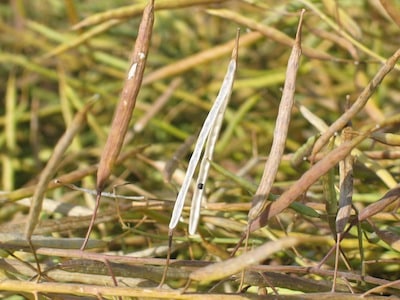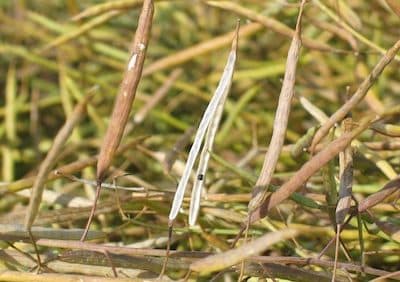
Swathing canola when temperatures are hot can cause two potential problems for the crop:
1. Rapid dry down due to hot conditions does not give the green-clearing enzymes enough time to reduce chlorophyll levels in the seed, and green counts can be elevated.
If canola dries down to 10% moisture in 3 days, that’s too fast for de-greening to finish. The de-greening process can restart in swathed canola with enough moisture, but the best solution is to leave the crop standing to cure further before swathing. Swathing at night may not help, as rapid dry down will simply resume in the morning. Wind further increases the dry down rate. Humidity, on the other hand, slows the dry down rate. Hot humid conditions are more favourable for green-clearing function than hot dry conditions. In which case, dew trapped in a tight night-swathed windrow may help slow dry down for plants in the middle of the windrow.
Swathing on a hot day is fine if seed colour change (SCC) is approaching 60% on the main stem, and the plant doesn’t have many side branches. The risk of green seed is low on this plant. However, if the crop has large plants with multiple branches, and if SCC has not started on the side branches, cutting this crop on a hot day can present a high risk for green seed in the harvest sample.
A stand of 2-4 plants per square foot has triple the amount of seed on later branches than there would be with a stand of 10 plants per square foot. These later branches will have the most green seed compared to the main stem and primary branches. Make sure seed on side branches is at least firm to roll, even if SCC has not started.
A note on yield loss: Cutting on a hot day will have a minimal effect on yield loss due to shrinkage — as long as seeds are below 35-40% moisture dry basis (about 25-30% wet basis). Seeds will range from flecks of colour change to light brown. At this seed moisture content, seeds are physiologically mature with dry matter filling finished, and thus the rate of dry down is no longer a problem for seed size or seed yield. Green, yes. Yield, no.
2. Very dry pods can shatter if swathed on a hot day.
This is where cutting on a hot day can lead to yield loss. And in this case, swathing at night can help. Cooler temperatures and nighttime humidity add some pliability to the pods, making them somewhat more resistant to shattering.
Is the shatter loss risk higher for swathed or standing crop? Research has shown that with wind speeds below 50 mph, a tight swath rolled into the stubble provides more wind protection against shattering than a standing crop. However, as wind speeds increase above 50 mph, this relationship flips. At higher wind speeds, swaths start to roll, and losses can greatly exceed those of standing crop.

